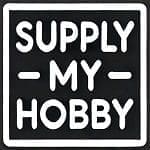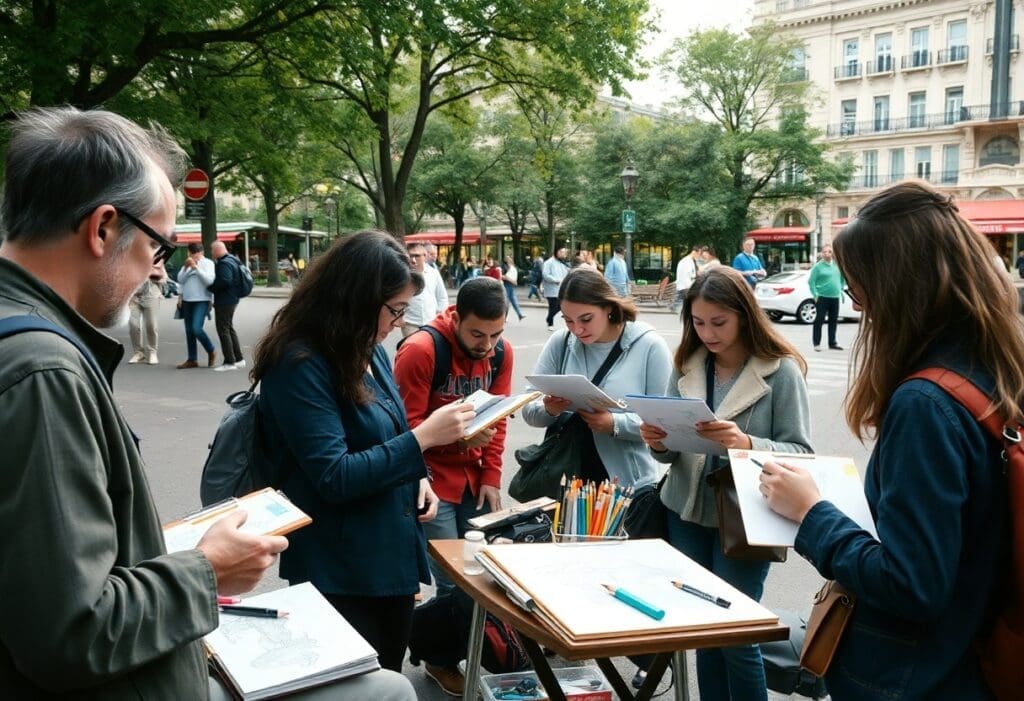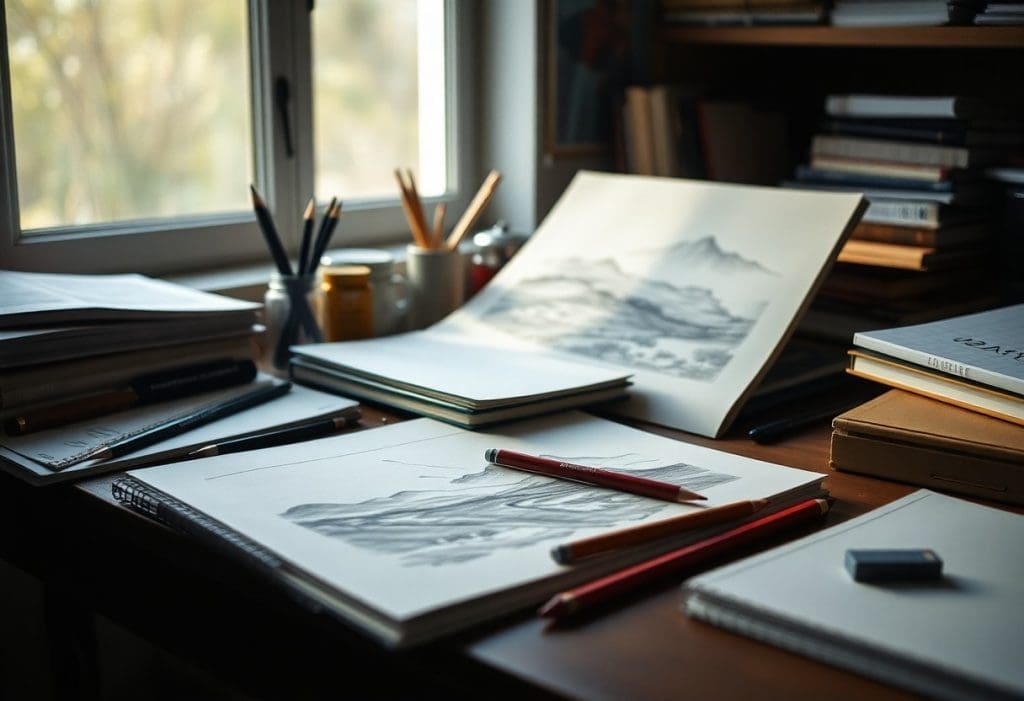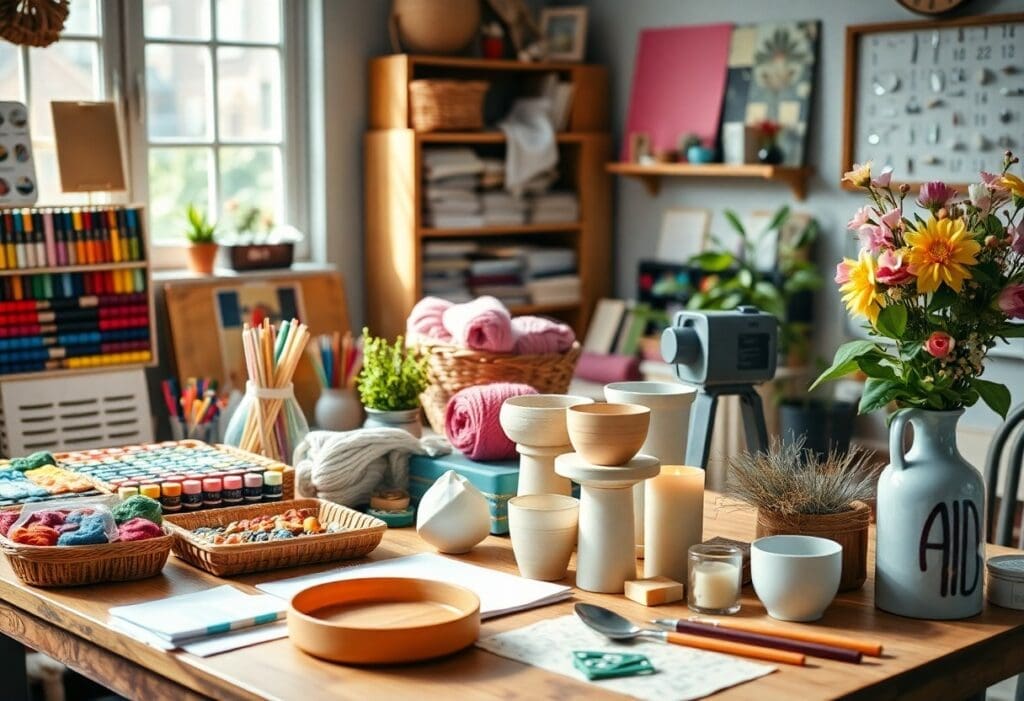Many city dwellers like you seek an expressive outlet to capture the vibrant energy and unique architecture of urban life. Urban sketching offers a wonderful opportunity to fuse creativity with observation as you explore your surroundings.
Armed with just a sketchbook and some simple drawing tools, you can transform everyday scenes into personal masterpieces, fostering both mindfulness and artistic growth.
In this guide, you’ll discover helpful tips, imperative tools, and inspiration to begin on your own urban sketching journey, enriching your urban experience along the way.
The Allure of Urban Sketching: Why This Hobby Captivates City Dwellers
The Emotional Connection: Finding Beauty in the Everyday
Urban sketching invites you to see the extraordinary in the ordinary.
As you stroll through your neighborhood, the mundane barriers between spaces dissolve, revealing the intricate details in weathered storefronts, the interplay of light and shadows on pavement, and the stories told through graffiti.
Each sketch transforms these fleeting moments into lasting memories, encouraging you to appreciate the unique charm hidden within routine settings.
Connecting with the Environment: Sketching as a Mindfulness Practice
Engaging in urban sketching immerses you deeply in your surroundings, fostering a sense of mindfulness that is often missing in the hustle of city life. As you focus your gaze on a particular scene, the rhythm of your pencil gliding over paper encourages you to observe the details and connect with the environment around you.
This practice allows you to slow down and embrace the present moment.
Rather than rushing through urban spaces, sketching turns you into an active participant in the rhythm of city life.
You might notice the subtle movement of people, the gentle rustle of leaves, or even the complex architecture of nearby buildings.
In a world defined by constant distractions, drawing becomes a meditative exercise, helping to ground you and enrich your appreciation of your everyday surroundings.
Engaging your senses and mind, urban sketching transforms routine observations into creative expressions, allowing you to connect on a more profound level with your environment.
Essential Tools of the Trade: Gear Up for Success
Sketchbooks: Choosing the Right Paper for Your Style
Selecting the right sketchbook can profoundly impact your urban sketching experience.
Consider your preferred medium—watercolor, ink, or pencil—and choose paper that complements it.
For ink and general sketches, a heavier-weight paper (around 160-300 gsm) can prevent bleed-through, whereas lighter paper might suffice for pencil work.
Brands like Moleskine or Stillman & Birn offer various options tailored to different styles, ensuring you capture the vibrancy of city life with ease.
Drawing Instruments: Pencils, Pens, and the Art of Ink
Your choice of drawing instruments shapes the style and quality of your sketches.
Pencils are versatile, with varying hardness giving you control over shading and detail.
Fine-liner pens, such as Micron or Faber-Castell, provide precision for outlining and details, while brush pens offer a dynamic range for expressive lines.
By adopting a mix of tools, you can experiment with techniques, creating unique textures and styles that define your personal urban sketches.
Using a combination of drawing instruments enhances your creative possibilities.
For instance, start with a light pencil (HB or 2B) for initial lines. As you gain confidence, switch to a fine-liner for crisp outlines. Incorporating brush pens can add fluidity and depth to your work, allowing for variable line widths and texture variations.
Experimenting with watercolor pencils or colored inks can also infuse vibrancy into your sketches, offering a full palette of expression as you navigate and capture the spirit of urban environments.
Unlocking Your Artistic Potential: Skills Development Strategies
Basic Techniques for Beginners: Lines, Shapes, and Shading
Starting with the fundamentals of urban sketching helps you develop a strong foundation. Focus on practicing simple lines, shapes, and shading techniques by drawing everyday objects.
Continuous practice of line work will improve your ability to depict structures, while mastering shapes and shading will enhance your depth perception.
Advanced Techniques: Perspective, Composition, and Color Theory
Diving into advanced techniques opens up a world of possibilities in your urban sketching.
Perspective allows you to create depth and dimension by drawing scenes as they appear to the human eye, ensuring your sketches resonate with realism.
Composition is about arranging elements harmoniously, guiding the viewer’s gaze through the artwork.
Understanding color theory equips you with the knowledge to choose color palettes that evoke emotion, adding layers of meaning to your work.
- Learn one-point and two-point perspective techniques to depict cities accurately.
- Experiment with layout and focal points within your sketches for improved composition.
- Explore color mixing and complementary colors to enhance visual interest.
| Technique | Description |
|---|---|
| Two-Point Perspective | Helps to create realistic depth, especially in urban settings with intersecting lines. |
| Rule of Thirds | Guides the placement of subject matter for a balanced visual appeal. |
Mastering these advanced techniques not only elevates your urban sketching but also engages your creative instincts. Perspective enhances your ability to portray bustling street scenes accurately, while composition draws the viewer into your world.
Color theory enables you to communicate mood and atmosphere effectively, making your sketches not just representations, but emotional narratives of the urban experience.
- Apply the golden ratio to develop more visually appealing compositions.
- Use contrasting colors to create emphasis on focal points within your sketches.
- Practice different lighting scenarios to explore how colors change throughout the day.
| Techniques to Explore | Benefits |
|---|---|
| Light and Shadow Play | Adds depth and interest, illustrating the effects of varying light quality. |
| Mixed Media | Combining watercolor with ink can enhance vibrancy and mood in your sketches. |
Cultivating a Sketching Routine: Making Time for Creativity
Finding Your Perfect Sketching Spot: Parks, Streets, and Cafés
Identifying an ideal spot for your urban sketching can dramatically enhance your creativity.
Parks provide a serene environment with natural elements, while busy streets offer dynamic scenes filled with architectural details and the hustle of everyday life.
Cozy cafés can be perfect for capturing the casual ambiance of city life, allowing you to sketch people and conversations unfolding around you.
Explore various locations regularly, as each will bring its own unique inspiration and energy to your sketches.
Setting Realistic Goals: From Daily Doodling to Comprehensive Projects
Establishing achievable goals is important for maintaining motivation in your urban sketching journey.
You might start with quick, daily sketches, allowing you to capture the essence of your surroundings without the pressure of perfection.
Gradually, you can progress to larger projects, such as themed series or community events, which can take more time but allow for deeper exploration of a specific subject.
By measuring your progress and celebrating small victories, you’ll find joy in the process and develop a fulfilling routine that nurtures your creativity.
Setting realistic goals entails recognizing your own pace and scheduling commitments. If you manage to sketch three times a week, keep that consistent rather than feeling pressured to sketch daily.
Perhaps you aspire to complete a themed sketchbook over the next six months; breaking it down into monthly projects can help maintain focus.
Staying flexible and allowing room for spontaneous inspiration can create an enjoyable rhythm to your sketching activities, leading to a richer portfolio over time.
Building Your Urban Sketching Community: Networking for Growth
Online Platforms and Social Media: Showcase Your Work and Gain Feedback
Joining online platforms such as Instagram, Facebook, and dedicated sketching forums provides a fantastic avenue to showcase your urban sketches and connect with fellow artists.
By sharing your work and engaging in discussions, you can gain valuable feedback, learn new techniques, and stay inspired by the creativity others express.
Many of these platforms also host challenges or themed sketching events, offering opportunities for you to participate and improve your skills while gaining visibility within the urban sketching community.
Local Groups and Meetups: The Benefits of Sketching with Others
Sketching becomes even more rewarding when you share the experience with others. Local groups and meetups foster a sense of camaraderie and serve as a platform for exchange.
These gatherings allow you to observe varied techniques, receive constructive critiques, and embrace collective inspiration that can fuel your artistic growth.
In addition, sketching in a group can spark creativity, motivate regular practice, and create lasting friendships built around a shared passion for urban sketching.
Local meetups often take place in parks, busy street corners, or popular cafes, giving you the chance to explore your city while engaging with fellow artists.
Whether you attend a few sessions or become a regular, the experience enriches your skill set.
One group in San Francisco meets every Saturday to sketch iconic landmarks. Participants often leave with not just completed sketches but also new friendships and collaborative projects.
By building connections, you’re supporting one another, exchanging tips, and developing as a community—all while enjoying the vibrant city environment around you.
Transforming Sketches into a Narrative: Storytelling Through Art
Capturing Moments: The Power of a Single Sketch
A single sketch holds the potential to encapsulate an entire story within its lines.
Whether it’s a bustling city street at dawn or a quiet café filled with afternoon light, each stroke conveys emotions, interactions, and atmosphere.
It’s your chance to convey a moment that viewers can interpret in multiple ways, inviting them to experience the scene as you saw it.
The beauty of urban sketching lies in these fleeting glimpses of life that can spark curiosity and conversations long after the ink has dried.
Creating a Series: Developing Themes and Projects
Creating a cohesive series of sketches allows you to explore narratives and themes over time.
By focusing on specific subjects—such as local architecture, public parks, or community events—you can deepen your understanding of these elements while crafting a captivating story.
Each piece contributes to a larger conversation, providing context and inviting viewers to see not just a single moment, but a collection of experiences that reflect your unique perspective as an artist.
Delving into a series can also ignite deeper connections within your community.
For instance, you might choose a theme like “The Faces of My Neighborhood,” where each sketch highlights different local personalities.
This not only fosters engagement with your subjects but also encourages conversations around the collective identity of your area.
Over time, you’ll find that your sketches transition from individual snapshots to a rich narrative tapestry.
This will, in turn, draw your audience in and encourage them to see their surroundings through your artistic lens.
The Intersection of Digital and Traditional Techniques: Blending Methods
Digital Tools for Urban Sketchers: Apps and Editing Software
In today’s tech-savvy world, numerous apps and editing software can enhance your urban sketching experience.
Consider using Procreate for iPad, which offers a wide array of brushes and layering options that mimic traditional media.
Adobe Fresco also excels in replicating watercolors and inks, perfect for sketching on-the-go.
Additionally, you can explore apps like SketchBook or Concepts to quickly capture ideas.
And editing tools like Photoshop can help you refine and embellish your sketches post-creation.
These digital platforms provide versatility, helping you develop your unique artistic voice.
Merging Techniques: How to Combine Digital and Traditional Sketches
Combining traditional and digital techniques offers a dynamic approach to urban sketching.
You might find yourself starting with a hand-drawn sketch, scanning it, and then using software to layer colors or textures.
Alternatively, work digitally in a drawing app while referencing your surroundings through an observational sketching process.
This blend not only expands your creative potential but also allows for exciting experimentation with styles and media.
To effectively merge techniques, start by sketching your scene on paper with your preferred traditional mediums—whether graphite, ink, or watercolor.
Afterward, scan or photograph your sketch to import it into an editing program such as Adobe Illustrator.
Here, you can use digital tools to add colors, backgrounds, or intricate details that might be difficult to achieve by hand alone.
Many artists further enhance their works by taking advantage of layering options, providing depth and dimension.
The fusion of both worlds not only enriches your creative process but also can yield surprisingly stunning results that highlight the beauty of both techniques in a single piece.
Exhibiting Your Work: From Social Media to Gallery Shows
Crafting an Online Portfolio: Showcasing Your Art Effectively
Building an online portfolio is vital for displaying your urban sketches to a broader audience.
Select a user-friendly platform that allows you to arrange your work thoughtfully, ensuring each piece is represented well.
Use high-quality images and take the time to write engaging descriptions that tell the story behind each sketch.
Incorporate a blog or social media links to help keep your portfolio dynamic, inviting potential viewers to follow your creative journey.
Preparing for Gallery Exhibitions: From Concept to Presentation
Transforming your sketches into a captivating gallery presentation requires thoughtful planning and attention to detail.
Start by conceptualizing a theme that ties your pieces together, allowing for a cohesive experience.
Consider the physical layout of the exhibition space—how your art interacts with light, movement, and viewer engagement.
The display techniques you choose, whether framed or unframed, can significantly impact how your work is perceived and appreciated.
Additionally, creating artist statements or captions for each piece can enhance viewers’ understanding and appreciation of your artistic perspective.
Conclusion
Taking this into account, urban sketching offers you a unique opportunity to engage with your city in a creative and meaningful way.
By capturing everyday scenes and architectural details, you not only enhance your artistic skills but also develop a deeper appreciation for your surroundings.
This hobby invites you to slow down, observe, and connect with the vibrant life of urban spaces.
So grab your sketchbook, and start exploring; your city awaits your artistic touch!



